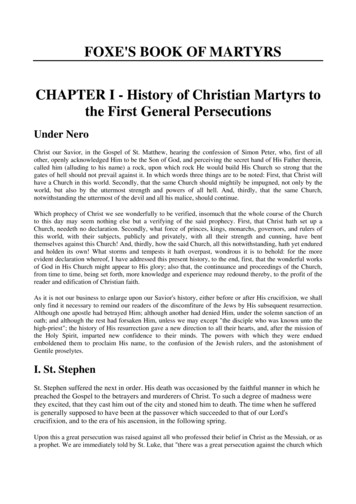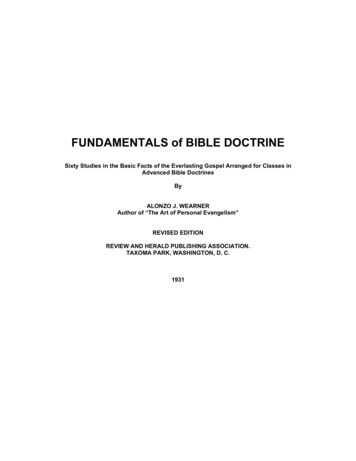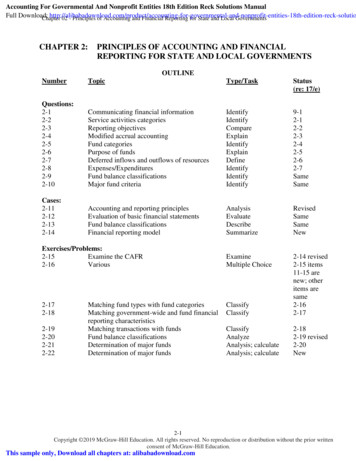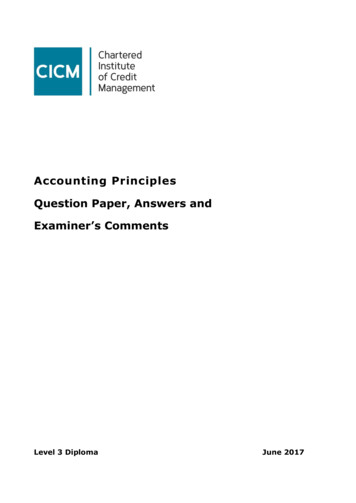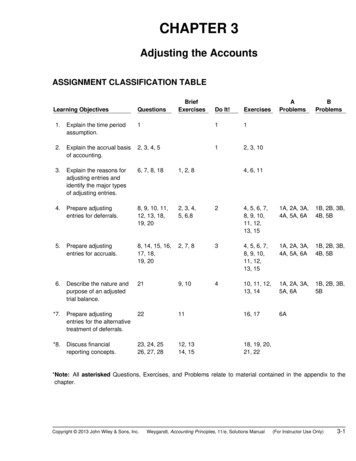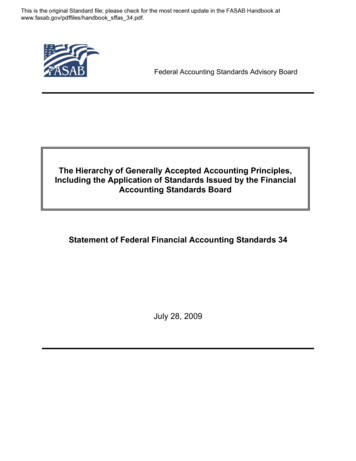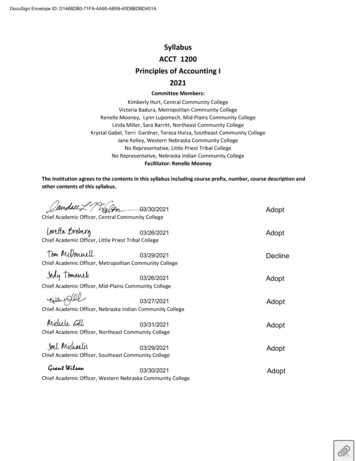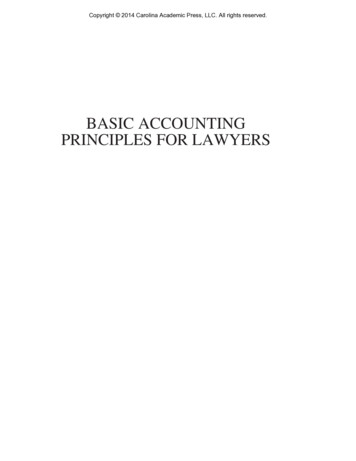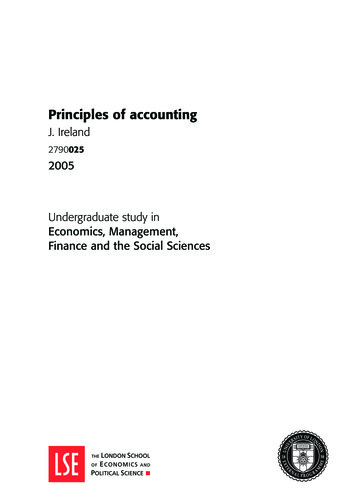
Transcription
Principles of accountingJ. Ireland27900252005Undergraduate study inEconomics, Management,Finance and the Social Sciences
This guide was prepared for the University of London External Programme by:Jennifer Ireland, Department of Accounting and Finance, London School of Economicsand Political Science.This is one of a series of subject guides published by the University. We regret that dueto pressure of work the author is unable to enter into any correspondence relating to,or arising from, the guide. If you have any comments on this subject guide, favourableor unfavourable, please use the form at the back of this guide.This subject guide is for the use of University of London External students registered forprogrammes in the fields of Economics, Management, Finance and the Social Sciences(as applicable). The programmes currently available in these subject areas are:Access routeDiploma in EconomicsBSc Accounting and FinanceBSc Accounting with Law/Law with AccountingBSc Banking and FinanceBSc BusinessBSc Development and EconomicsBSc EconomicsBSc (Economics) in Geography, Politics and International Relations, and SociologyBSc Economics and ManagementBSc Information Systems and ManagementBSc ManagementBSc Management with Law/Law with ManagementBSc Mathematics and EconomicsBSc Politics and International RelationsBSc Sociology.The External ProgrammePublications OfficeUniversity of London34 Tavistock SquareLondon WC1H 9EZUnited KingdomWeb site: www.londonexternal.ac.ukPublished by: University of London Press University of London 2005Printed by: Central Printing Service, University of London, England
ContentsContentsIntroductionThe study of accountingAims of the unitLearning outcomesReadingStructure of the subject guideHow to use the subject guideExamination adviceList of abbreviations used in this subject guideChapter 1: Accounting in contextAims and learning objectivesEssential readingFurther readingIntroductionWhat is accounting?Accounting theory and practiceAccounting information and its usesFinancial accountingManagement accountingSummarySample examination questionChapter 2: Fundamentals of financial accountingAims and learning objectivesEssential readingFurther readingIntroductionAn introduction to the financial statementsAccounting concepts, bases and policiesSummarySample examination questionChapter 3: Data processingAims and learning objectivesEssential readingFurther readingIntroductionOne transaction: two effectsRecording transactions: books of prime entryGetting it right: internal controlDouble-entry bookkeepingTrial balanceSummarySample examination questionChapter 4: Preparing financial statements 1Aims and learning objectivesEssential readingFurther readingIntroductionInventory, purchases and salesAccruals and i
Principles of accountingBad and doubtful debtsDepreciation of fixed assetsDisposal of fixed assetsSummaryExamination questionsChapter 5: Preparing financial statements 2Aims and learning objectivesEssential readingIntroductionPreparing the balance sheet and profit and loss accountIncomplete informationA note on suspense accountsSummarySample examination questionChapter 6: Preparing financial statements 3Aims and learning objectivesEssential readingFurther readingIntroductionDifferent formats for different purposesPreparing company accountsPreparing the cash flow statementSummarySample examination questionsChapter 7: Using and understanding financial statementsAims and learning objectivesEssential readingFurther readingIntroductionRatio analysisWriting a reportSummarySample examination questionChapter 8: Alternative valuation approachesAims and learning objectivesEssential readingIntroductionAccounting profit and economic incomeHistoric cost accounting and current valuesSummarySample examination questionChapter 9: Fundamentals of management accountingAims and learning objectivesEssential readingIntroductionPlanning and co-ordinationControl, communication and motivationInformation for decision-makingSummaryChapter 10: Cost accountingAims and learning objectivesEssential readingFurther 26129129131131131131132134135135137137137137
ContentsIntroductionUnderstanding costsStock valuation – marginal costingStock valuation – full costingEffects of different stock valuation methodsSummarySample examination questionsChapter 11: Making decisions 1Aims and learning objectivesEssential readingFurther readingIntroductionCost-volume-profit analysisRelevant costsLimiting factorsSummarySample examination questionsChapter 12: Making decisions 2Aims and learning objectivesEssential readingFurther readingIntroductionCapital investmentsPayback periodAccounting rate of return (ARR)SummarySample examination questionChapter 13: Making decisions 3Aims and learning objectivesEssential readingFurther readingIntroductionDiscounted cash flow techniquesSummarySample examination questionsChapter 14: Planning for the futureAims and learning objectivesEssential readingFurther readingIntroductionGoals and objectivesBudgets and forecastsWorking capital managementSummarySample examination questionChapter 15: Budgets for controlAims and learning objectivesEssential readingFurther readingIntroductionStandard costsBehavioural effects of using budgetsVariance analysis – an 195195195195196197198iii
Principles of accountingivSummarySample examination questionAppendix 1: Suggested solutions to selected activities andsample examination questions206207209Appendix 2: Sample examination paper280
IntroductionIntroductionThis subject guide is written for those of you who are studying Principles ofAccounting. The unit is intended as a broad introduction to the subject, bothfor non-specialist students, and as a foundation for further study in the area.The study of accountingFrom the outside, accounting can appear to be a purely practical subject. Itwould be very easy to focus on just the applications of techniques andprocedures. But accounting is more than just a set of calculations; unlesswe can understand and interpret the figures we produce, the calculationsare pointless!Accounting provides information for a wide variety of different users andpurposes, and its practices can only be properly understood and assessed inrelation to the economic and social environment in which they are applied.Therefore there are four aspects to this subject:1. Techniques for recording, calculation, classification and reporting ofaccounting information.2. The legal and institutional background associated with accountinginformation.3. The economic and administrative problems which the informationis required to solve.4. The interpretation of reports prepared using 1 in the light of 2 and 3.The accounting information referred to in 1 need not be financial, althoughfor our purposes in this unit it will almost always be.The problems referred to in 3 are largely concerned with the planning of,and control over, the use of economic resources. They are also concernedwith the measurement of income and of various kinds of value changes.In order to properly interpret accounting information as in 4, and apply itto the problems in 3, we need to understand the theory and principleswhich underlie the techniques in 1.The study of accounting is traditionally divided into two parts according tothe types of users of the accounting information. Financial accounting isprimarily concerned with the needs of users outside the business (or otherorganisation). Therefore it relates to the external control and managementof resources (for example, by shareholders of the company in which theyhave invested their funds, or by banks making loans). A key part offinancial accounting is reporting the performance and position of thebusiness to these external users, via the financial statements. The formand content of financial statements is usually highly regulated. In contrast,management accounting is concerned with the needs of users inside thebusiness. Therefore it relates to the internal control and management ofresources (for example, by the directors, management or employees of acompany). Management accounting statements may be more detailed thanthose prepared for external users, and do not normally need to meet anylegal requirements.Countries around the world organise their economic and financial activitiesin different ways so, inevitably, legal requirements, regulation andadministrative procedures also vary across countries. The syllabus is basedon the system pertaining to the UK, but the amount of institutional1
Principles of accountingmaterial that you need to know is kept to a minimum. Even though thematerial in this text is based on the system in the UK, accounting rules andguidelines around the world are becoming more similar (converging). Thisis part of a general drive to harmonise international accounting practices.It is important to note that a knowledge of UK Statements of StandardAccounting Practice and Financial Reporting Standards, and ofInternational Accounting Standards, is not part of the syllabus.Aims of the unitThe aims of the unit are to: introduce you to the principles underlying accounting enable you to apply, interpret and explain key accounting techniques provide a broad understanding of the theory and practice of financialand management accounting.The unit is intended both for non-specialist students, and as a foundationfor further study in the area.Learning outcomesBy the time you sit the examination, you should be able to: distinguish between different uses of accounting information and relatethese uses to the needs of different groups of users explain and apply financial accounting concepts and conventions prepare basic financial statements from both structured andunstructured data analyse, interpret and communicate the information contained in basicfinancial statements, and explain the limitations of such statements andtheir analysis categorise cost behaviour, and prepare and contrast stock valuationsunder different costing methods describe the budgeting process and discuss the use of budgets inplanning and control explain, discuss and apply relevant techniques to aid internal users indecision-making.ReadingEssential readingGlautier, M.W.E. and B. Underdown Accounting theory and practice. (Harlow:Financial Times Prentice Hall, 2001) seventh edition [ISBN 0273651617].Further readingMcLaney, E. and P. Atrill Accounting: an introduction. (Harlow: Financial TimesPrentice Hall, 2002) second edition [ISBN 0273655507].Those who prefer to use a textbook other than that by Glautier andUnderdown (2001) (including if you are using an earlier edition of Glautierand Underdown) should ensure that all topics outlined in this subject guideare covered. In addition, you should ensure that appropriate emphasis isplaced on underlying theories and principles, and the ability to explain andinterpret accounting information, as well as the preparation of thisinformation.2
IntroductionThose who have problems with double-entry bookkeeping may find ituseful to refer to McLaney and Atrill (2002). This text is of general useas a second source of information and examples for most other areas of thecourse. The text also has a companion website.Supplementary readingAccounting is an evolving and, at times, controversial subject. You areencouraged to stay informed of the current issues in accounting. Theseissues are often reported in the press, so this may be done by reading thefinancial pages of a quality daily, or weekly, newspaper. In addition,specialist publications which are worth reading on a regular basis includeAccountancy, the official monthly journal of the Institute of CharteredAccountants in England and Wales, and Accountancy Age (available onlineat www.accountancyage.com). Journals of other professional accountancybodies in the UK and elsewhere are also suitable. Press, comment andother information can also be found at www.accountingweb.co.uk.In recent times, accounting for pensions and financial instruments havebeen regular features in the UK news. Your country may have very differentaccounting issues. You may not be able to understand all the technicaldetails, but you should try to understand the main arguments. Who do youthink is right, and why? What may be the real motivations behind thearguments? How do the policy-makers respond? What are the causes ofaccounting scandals that occur? What do you think can be done to preventthese scandals, and why?Reference booksCollin, P.H. Dictionary of accounting. (London: Bloomsbury, 2004) third edition[ISBN 0747569916].Hussey, R. A dictionary of accounting. (Oxford: Oxford University Press, 1999)second edition [ISBN 019280099X].Nobes, C. The Penguin dictionary of accounting. (London: Penguin Books, 2002)first edition [ISBN 0141514880].These (or any similar) dictionaries of accounting provide a quick source ofreference for any new terms you meet in this subject. You may find adictionary particularly useful when you approach this subject for the firsttime, as accounting terminology can sometimes cause unnecessaryconfusion. You should be aware that precise terminology, particularly withrespect to financial reporting terms, may differ from one country toanother. If you do not have a dictionary of accounting, you should be ableto find the information you need in either Glautier and Underdown, orMcLaney and Atrill.Structure of the subject guideThis subject guide is divided into 15 chapters which, with the exception ofChapter 1, are organised in two sections: Chapter 1 is a general introduction to the subject, which alsodistinguishes between financial and management accounting. Chapters 2–8 form Section 1 on financial accounting. This sectionintroduces and explains financial accounting concepts and conventions,and provides a grounding in double-entry bookkeeping and thepreparation of basic financial statements. This section also enables youto analyse and interpret the information contained in these financialstatements, and to explain their limitations, with reference to3
Principles of accountingunderlying theories and principles. Although a grounding in doubleentry bookkeeping is provided, you should note that it is possible toprepare basic financial statements from both structured andunstructured information without making use of this technique;double-entry bookkeeping is used by businesses to record financialtransactions as they occur, but if this data is already provided then itcan be directly manipulated for financial reporting purposes. Chapters 9–15 form Section 2 on management accounting. This sectionintroduces a range of management accounting applications andtechniques for planning, decision-making and control. These techniquesare supported by discussion of the underlying theories and principles,and emphasis is placed on the ability to interpret and critique their use. Finally, Appendix 1 gives some suggested solutions to the exercisesand sample examination questions set in the chapters. Appendix 2contains a sample examination paper and extracts from interest(discount factor) tables.How to use the subject guideThis subject guide is intended to supplement the essential readingindicated in the text, not to replace it. The guide relies on therecommended text (Glautier and Underdown) to provide the theoreticalgrounding for the material and for many definitions, examples andexplanations. The subject guide: provides a framework for your study of the subject using therecommended text contains aims and learning objectives for each topic, and referencesto the essential and further reading acts as a pointer to the most important issues dealt with in the reading provides additional explanations where appropriate contains additional worked examples, exercises for you to work throughyourself, and sample examination questions.It is important to attempt all the exercises and to ensure you take the timeto fully understand the material covered in each chapter of the subjectguide.You should complete Chapter 1 first of all, before progressing to the othersections of the guide. Thereafter, you are strongly advised to attempt thework relating to financial accounting (Section 1) in the order in which it ispresented in the guide. However, you may progress to Section 21(management accounting) before attempting Chapters 7 and 8. Althoughit is also important to attempt the work relating to management accountingin the general order in which it is presented in the guide, Chapters 14 and15 may be attempted (in that order) at any time after you have completedChapters 9 and 10.It is also possible to leave part of Chapter 3 (Data processing) and return toit at a later date, if it is causing you problems. The section of this chapterthat you may return to later deals with double-entry bookkeeping. Youwill see that it is not necessary to perform double-entry bookkeeping whenpreparing financial statements from structured and unstructuredinformation. The most important part of this chapter to understand beforeprogressing onwards is the interpretation, rather than the production,of the trial balance.41It is important to studyChapters 2–6 on financialaccounting before starting thematerial on managementaccounting, because you willneed to understand bothterminology from the financialaccounting material, and the waythat financial statements fittogether, in order to understandall of the material onmanagement accounting.
IntroductionIt is essential to have a good understanding of the underlying principles offinancial accounting before moving onwards as the steps which culminatein the preparation (and interpretation) of financial statements arecumulative. However, you may find that the work on managementaccounting falls more readily into separate, albeit related, topics. Inparticular, Chapters 11–13, on decision-making techniques, may beattempted separately from Chapters 14 and 15, on the use of budgets forplanning and control.Unless indicated otherwise, the order in which you should tackle the workspecified in each chapter is as follows:1. Read the chapter aims and learning objectives, and the introduction, toappreciate what material will be covered in the chapter, and what youare expected to achieve by the end. Bear these in mind as you workthrough the chapter.2. Read through the specified essential reading (in Glautier andUnderdown) to acquire an initial understanding of the text.3. Work through the material in the subject guide chapter. Pay particularattention to the examples provided, as they contain materials that areeither complementary to the textbook, or otherwise important toensure you gain a full understanding of the material.4. As you are working through the material in the subject guide chapter,attempt each Activity at the appropriate point. You may need to referback to relevant parts of the specified reading in Glautier andUnderdown in order to do so. If you are still unsure, you could also referto the relevant chapters specified in the further reading (McLaney andAtrill). Solutions for numerical Activities are provided in Appendix 1.5. Make notes from the specified reading and the subject guide chapter forfuture reference. If you struggled with any of the exercises, try to ensurethat your notes will help you to avoid the same problems when youreview the chapter at a later date.6. Your knowledge and understanding will be reinforced if you also tackle thequestions at the end of the corresponding Glautier and Underdownchapter(s). If you find you are having difficulties, you should work throughthe subject guide material again before returning to the questions.7. Check that you have achieved the learning objectives befor
Accounting is an evolving and, at times, controversial subject. You are encouraged to stay informed of the current issues in accounting. These issues are often reported in the press, so this may be done by reading the financial pag

